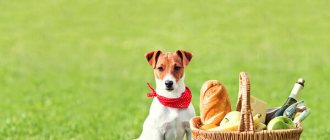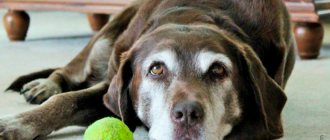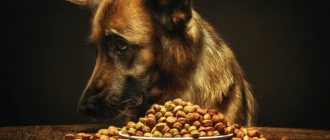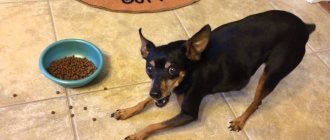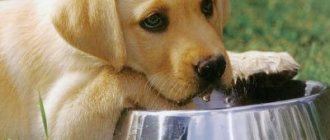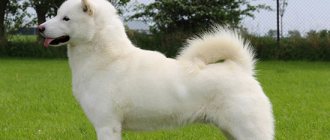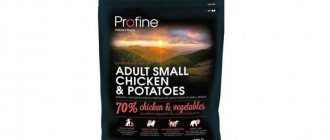Feeding dry food
Choose well-known and proven brands, then you will get all the benefits of “dry” feeding - a balance of nutrients, vitamins and microelements for dogs, a minimum of time costs for you. Add wet canned food of the same brand to dry food. Don't forget about fresh water - there should be plenty of it. In summer, change it several times a day.
Feed comparison
Acana Grass-Fed Lamb
Hypoallergenic, biologically suitable for dogs (holistic), intended for sensitive animals. Contains half and half lamb and vegetables. Does not contain potatoes or grains.
Eukanuba Breed Specific Dry Dog Food Labrador Retriever
Ready food for Labradors. Its basis: poultry (chicken) and cereals. Enriched with calcium. Prevents the formation of tartar.
Advance Labrador Adult
With chicken, grains and dietary supplements for teeth, coat, heart and joints. Designed for adult dogs.
Hill's Nature's Best Canine Adult Large Breed/Giant Dry
The food is optimized for large and giant breeds. Main ingredients: corn, chicken and turkey. Suitable for Labradors as it contains glucosamine and chondroitin for joint health.
Royal Canin Labrador Retriever Adult
Food that takes into account the health problems and needs typical of Labradors: tendency to obesity, stress on joints, water-repellent properties of wool. Contains rice and other grains, poultry.
Puppies nutrition
Until four weeks of age, Labrador puppies feed exclusively on their mother's milk. From one month on, babies can be gradually introduced to natural food. From one month to three months of age, the puppy’s diet includes cow’s milk, cottage cheese of moderate fat content, viscous porridge without salt and sugar, meat ground and processed in boiling water (veal, beef, chicken), vegetables (carrots, pumpkin, zucchini). The puppy is fed 6 times a day, organizing meals in this order:
- milk;
- cottage cheese;
- porridge;
- milk;
- vegetables with vegetable oil;
- meat.
During the day, a puppy can consume 200-300 grams of milk, 100-150 grams of cottage cheese, up to 150 grams of rice porridge, 250-350 grams of meat. Vegetables are given in the amount of 100 grams per day, seasoned with a teaspoon of vegetable oil.
From then until four months, the Labrador puppy eats 4 times a day:
- cottage cheese with milk;
- porridge;
- vegetables with vegetable oil;
- meat.
The number of products consumed increases by one and a half times compared to the previous period.
From four to six months, the Labrador takes food 4 times a day in this order:
- cottage cheese with kefir – 500 grams in total;
- porridge (rice, buckwheat) – 300 grams;
- vegetables – 300 grams;
- meat – up to 600 grams.
From the age of six months, low-fat sea fish without bones is introduced into the puppy’s diet in the amount of 600 grams per day.
As soon as your Labrador puppy turns 6 months old, he can be fed three meals a day. In the morning, the pet is given a five-hundred-gram portion of cottage cheese with kefir. During the day, the dog is fed porridge (serving – 250 grams). The last meal is meat with salad (500 grams of meat, 200 grams of vegetables).
From 8 months, Labrador retrievers are given 2 meals a day. In the morning, the dog is fed cottage cheese with kefir (500 grams). In the evening, the animal is given porridge with meat or meat with vegetables (500 grams of meat, 250 grams of porridge). Once every 4 days, you can give your pet a boiled egg.
The puppy should always have access to fresh drinking water. It needs to be poured into a separate bowl and placed in the area of the room where your puppy is used to eating.
How to change the power plan
Transition your Labrador from one feeding regimen to another gradually, carefully monitoring all the dog’s reactions. The transition from natural food to dry food takes about 7 days, from dry to natural food - 2 weeks, since the pancreas needs time to fully restore its functions.
Do not mix types of food either in a bowl or at time: feed natural in the morning, dry in the evening.
The general translation scheme is as follows:
| Day | Share of natural feed, % |
| 1-7 | 30 |
| 8-10 | 50 |
| 10-14 | 70 |
| from 14 | 100 |
Natural diet
When feeding your dog natural food, you must remember: you will have to balance the nutrition in terms of nutrient content yourself, and this is not easy. Please note that it will take a lot of time and effort to prepare. Meat should be at least 50% in the diet, because dogs are carnivores. You should not feed your Labrador retriever food that is too hot or cold, stale, or improperly heat-treated (fried). Preferred Products:
- Lean meat (beef, turkey, chicken, horse meat, rabbit), offal: types that do not cause allergies, boiled, frozen or scalded, cooked offal, raw tripe, unpeeled;
- Sea fish: boneless (hake, cod, pollock), boiled to bind trimethylamine oxide, which causes anemia in animals;
- Dairy products (yogurt, yogurt, bifivit, cottage cheese, low-fat cheese), fresh milk (only for puppies up to 8 weeks old, a little at a time). Add calcium chloride to the milk feed (2 tablespoons per liter before boiling the milk);
- Porridge (rice, buckwheat), flavored with rye breadcrumbs and vegetable oils (linseed, sunflower, olive);
- Eggs (raw (with porridge) only the yolk, boiled or as an omelet - whole);
- Fruits (little by little, except grapes), vegetables (raw grated zucchini, carrots, pumpkin), herbs (dill, parsley, celery).
Sample menu for the week
| Day of the week | Menu |
| Monday | In the morning - cottage cheese with sour cream, fresh vegetables, in the evening - boiled beef, in pieces, with rice boiled in broth; |
| Tuesday | In the morning - an omelet with vegetables and cheese, raw beef, in the evening - chicken breast with buckwheat and herbs or fish; |
| Wednesday | like on Monday; |
| Thursday | like Tuesday; |
| Friday | In the morning - fresh vegetables, chopped, beef meat, raw, cut into pieces, in the evening - chicken fillet with rice; |
| Saturday | In the morning - cottage cheese with bifidok, porridge with vegetables, in the evening - beef with buckwheat and herbs; |
| Sunday | In the morning - porridge with breadcrumbs and herbs, cottage cheese. In the evening - boiled offal (raw tripe) with buckwheat. |
What foods should be in a puppy's diet?
Now let's talk about what to feed a Labrador puppy. We list the main products that can almost always be given to your baby (if, of course, there is no allergy to a particular product):
- Lean meat
(veal, turkey or chicken, rabbit). Most often, puppies are given boiled meat, but if you feed the animal raw meat, then it must be kept in the freezer for a week (at least 3 days) to destroy helminths. At an early age (at 1-2 months), it is advisable to give meat in highly chopped form; - Offal
– beef trachea, tripe, cartilage, heart, lungs, some liver. They are boiled and crushed, and then mixed with cereals or vegetables; - Sea fish
(cod, chum salmon, salmon, etc.). It is also given boiled without bones; - Dairy products
are fresh and low-fat (puppies up to 3-4 months old have porridge cooked in milk, and older dogs are usually given sour milk); - Cereals
– rice, buckwheat, oatmeal. They are cooked in the usual way using water, meat broth or milk, but without adding any sugar, butter or salt. As a rule, porridge for puppies is mixed with pieces of meat, fish or offal; - Vegetables
- pumpkin, zucchini, carrots, cauliflower, turnips, bell peppers. As a rule, vegetables are briefly boiled and chopped before serving to the dog. You can also give your puppy raw vegetables, chopped with a knife or grated, but only if there is no diarrhea. Not all dogs are delighted with vegetables, so they are usually added in small quantities to porridge or meat; - Greens
– parsley, dill, lettuce. The greens are finely chopped and added to dishes prepared for the puppy; - Vegetable oils
– flaxseed, sunflower, olive. They are added in small quantities (0.5-1 tbsp) to ready-made dishes; - Eggs
- quail or chicken. They are given to puppies once a week, 2-1 pcs. respectively.
What to feed a Labrador puppy
Your puppy will be stressed when moving to you. Don’t put him through the trouble of indigestion, find out from the breeder what kind of food he’s used to, and feed him the same thing, at least for the first time.
| Age, months | What to feed |
| up to 1 | breast milk |
| 1-2 | breast milk + complementary foods (dry food soaked in yogurt or kefir (not chicken-based), semi-liquid buckwheat, rice porridge; vegetables (except potatoes), cottage cheese, fish - all in puree form) |
| 3-4 | gradually wean off from “mother”, increase the share of ordinary soft food, replace cottage cheese with meat, poultry and fish cut into small pieces |
| 5-6 | accustom to solid foods rich in protein, vitamins and minerals (meat, sea fish, dairy products, fish oil, powdered eggshells, raw vegetables) |
| 6-10 | regular puppy diet (natural feeding or dry food “for large breed puppies” or “for Labrador Retriever puppies”) |
| 10-12 | transfer to an “adult” diet |
Teach your puppy:
- eat a single serving completely and immediately (keep the bowl of food available for no longer than 15 minutes, give the supplement a little at a time, only for puppies up to six months old),
- do not “beg” the host’s food (do not offer food from your table and forbid children to do this),
- leave the kitchen immediately after finishing the meal.
Look at the discipline these Labrador puppies have!
Ready-made food for Labrador puppies
The diet of many young Labrador retrievers consists of commercial dry and wet food. And the choice of their owners is justified: such products are balanced, healthy, nothing needs to be prepared, dry industrial food does not spoil for a long time, and wet food is available in portioned bags or jars. True, the price of high-quality canned puppy food and dry food is steep.
If the choice is still made in favor of industrial products, then what food should you feed your Labrador puppy? highly recommend giving preference to extra premium food
, the main component of which is a high-quality source of protein - natural meat and fish. The composition of such products, which are best absorbed by the dog’s body, contains at least 60-70% meat, while in premium level products there is about 35-20% meat, and in cheap economy class food there is often no meat (more precisely, meat ingredients of dubious quality). more than 10-5%.
So what brand of food is best for a small Labrador? We advise you to pay attention to such high-quality products (it is important to take into account that the packaging must certainly contain marks that the food is specifically for puppies: “Puppy”, “Baby”, “Junior”, etc., since food for adult dogs is for young not suitable for dogs):
- MONGE;
- ACANA;
- Orijen;
- GRANDORF;
- Brit Care;
- Bosch;
- EUKANUBA.
How to feed a Labrador puppy correctly
Observe the following rules from a very early age of the puppy:
- Feed and water from a high stand (bowls are fixed at the height of the animal’s elbows so that the dog’s posture does not deteriorate).
- Give slightly warmed food (30-37 degrees).
- Provide the puppy with peace afterward, do not take him for a walk to avoid stomach volvulus.
- Do not give food between feedings.
- Introduce new products gradually, starting with small quantities.
- In the first half of the day, feed lightly (dairy products), in the second - give the main part of the food (meat, eggs, vegetables, cereals) and vitamins, since in the afternoon and at night the secretion of gastric juice increases in Labradors.
- Follow a diet appropriate for the puppy's age.
| Puppy age, months | Frequency of feedings, once a day | Single (daily) portion, g |
| 1-2 | 6 | 50 (300) |
| 2-4 | 5 | 60-80 (300-400) |
| 4-6 | 4 | 100 (400) |
| 7-12 | 3 | ~130 (400) |
| from 12 | 2 | 250 (500) ± 70-100 |
Dry food is dosed in accordance with the manufacturer's instructions.
The greatest need for nutrients and biologically active substances occurs in young Labradors at 2-6 months; Pay special attention to your puppy's diet at this age.
From 4 months, feed supplements with calcium, glucosamine and chondroitin for the proper formation of bones and joints, prevention of rickets, hip dysplasia.
You can also watch a short video with an example menu for a Labrador puppy.
How to properly feed a Labrador puppy at home from birth to one year?
After birth, the puppy must suckle from its mother for up to four weeks, as it is fully provided with all nutrients.
The puppy is 1-2 months , how many times a day should I feed my Labrador? He is fed 5-7 times a day . The amount of food per day is 300 - 350 grams .
At 3-4 months, food is reduced to 4-5 meals , the amount should be approximately 400 grams .
After turning 5 months old, how many times should you feed your Labrador puppy? A pet from five months to a year should be fed 3 times a day in the amount of 500 grams (remove second breakfast and afternoon snack, including this food in breakfast and dinner).
After a year - 2 times a day , and the amount is 1 kg of food.
What to feed an adult Labrador
A dog’s diet affects its condition, coat condition, activity, and the presence of food allergies (diarrhea, vomiting, rashes, scratching, “running” ears).
Weigh your Labrador and calculate the daily amount he needs:
- meat and meat products - 10-20 g/kg weight (3-4 g/kg protein),
- fat 1-2 g/kg (1/6 of meat),
- carbohydrates - 5-6 g/kg (1/2 of meat).
Divide this amount into two meals: morning and evening. If the dog is inactive, it should be fed once a day.
With dry food it is easier to monitor the dog’s weight, the completeness of the diet, and control the manifestations of allergies than when feeding natural products.
Features of feeding Labrador puppies
Curious and overly active, Labrador Retriever puppies grow and develop very quickly, both physically and mentally. The diet of dogs in childhood should be designed taking into account all the needs of their body. Together with food, the body must receive substances that provide everything necessary for the development of muscles and skeleton.
For Labrador puppies you can choose:
- feeding with natural food;
- feeding with professional dry and canned food.
Daily feeding rate
Depending on the age of the dog, its daily food intake may vary. According to average data:
- puppies aged 1-2 months should eat 50 g of food at a time, they need to be fed 6 times a day;
- at the age of 2 to 4 months, Labradors eat 5 times a day, eating 60-80 g of food or “natural”;
- from 4 to 6 months, puppies are transferred to four meals a day, the volume of consumed portions increases to 100 g;
- from 7 to 11 months, the dog is able to withstand long intervals between feedings, the number of which is reduced to three (serving volume is 130g);
- after 11 months, a grown puppy is fed like adult dogs - 2 times a day, portions should be at least 350 g.
Important! The number of feedings and the volume of portions can be changed taking into account the needs of each individual individual.
How to choose dry and wet food
For all puppies, you must buy food whose packaging is marked Puppy or Junior. Labradors are fed products from lines specifically designed for representatives of this breed or for large dogs.
The granules in dry food are always not too large and not very hard. During periods of active tooth change, it is recommended to slightly soak them in warm water. Canned wet food can be used as a regular diet or as a treat. For daily use, it is better to buy food in cans. For other options, it is better to purchase spiders.
Important! Preference should be given to premium food, which is made from raw materials of the highest quality category. Using low-grade food can worsen your dog's health, cause allergies and slow down weight gain.
Subtleties of natural nutrition
Labrador puppies can be fed:
- cereal porridge;
- chopped lean meat;
- fermented milk products;
- vegetables, herbs;
- vegetable oil, which is added to porridge;
- egg yolks (quail and chicken).
Important! Products must undergo mandatory heat treatment, cut into small pieces or pureed in a blender.
What to feed an old dog
Age-related changes in the functioning of the Labrador's body are partially compensated by nutrition. It is corrected like this:
- add vitamins to slow down the withering process,
- reduce portions or calorie content of food (by 20%),
- enrich the diet with calcium for teeth and claws,
- add products with glucosamine (beef, hard cheese, cartilage, skin and tendons, salmon) to prevent arthritis,
- follow general nutritional rules, since older dogs often suffer from indigestion.
Dietary errors: excess weight
Vigor, activity, thick and shiny coat, ideal skin condition and normal weight - all this can be considered signs that you are feeding your pet correctly with natural foods. Unfortunately, not all owners manage to properly prepare a Labrador’s diet, which leads to a wide variety of health problems for the dog.
Obesity is the most common problem among Labradors. If your dog's weight begins to fall outside the normal range, reconsider the daily feeding schedule and the calorie content of his diet. It is also recommended to increase the duration of active walks, which will help normalize the pet’s weight.
Other signs of an eating disorder include:
- redness of the mucous membranes of the eyes and ears;
- diarrhea or constipation;
- rumbling in the stomach;
- severe hair loss.
If the owner of a Labrador retriever has questions regarding feeding the dog “natural” food, you should consult a veterinarian.
Feeding pregnant and lactating bitches
Pupping in Labrador bitches lasts about 2 months.
For the first half of the pregnancy, feed the pregnant dog unchanged (excess weight will complicate childbirth).
In the second , they increase the amount of meat (up to 1.5 kilograms per day or ~ 10-15% per week), vitamins and microelements (strictly observing the proportions) or simply switch to food for puppy bitches, the composition of which already takes into account the physiological state and needs animal in building material.
If the dog gets what it needs, then whelping and subsequent lactation will have little or no effect on its condition, coat quality and overall health.
If you switch the bitch to puppy food, there is no need to increase the portions or add vitamins and microelements. Feed your dog 6-8 hours after giving birth unless he asks sooner. With milk, a dog gives away 4-7% of its body weight every day. To ensure that the puppies grow up healthy and do not “drink” it, feed the bitch more often than usual (3-5 times) - the same as in the second half of pregnancy.
Remember about fresh water: it is needed for milk production. If the dog's diet is natural, its food should be liquid (thin porridge, meat soup, milk). Do not give potatoes: starch can clog the milk ducts.
A month to a month and a half after giving birth, gradually reduce the number of times the bitch feeds and the amount of water she drinks in order to smoothly complete the lactation period.
What is important to consider when feeding a puppy
So, we figured out what to feed a Labrador puppy at home. Now let’s find out what daily feeding rules it is important not to forget about:
- You should not force your baby Labrador to eat something that he absolutely does not like
. Yelling and pushing towards the bowl is simply unacceptable. It is much better to replace an unloved product with something of equal value (for example, dairy and meat products compensate for the absence of fish on the menu); - Your Labrador should be fed at approximately the same time every day.
; - There is no need to feed the puppy abundantly unscheduled, even if he really asks for it
. All Labradors are susceptible to obesity, so overfeeding at an early age is undesirable. If your pet begs for something tasty, you can treat him with homemade liver treats or dried meat (offal). Another option is a purchased tendon bone; - Uneaten food should not be present in the puppy’s bowl all the time
(we are talking about a natural puppy). You should set aside about 15 minutes for each meal. If the dog does not finish the entire portion at once, the food can be hidden in the refrigerator to be given later; - If the owner, due to being busy, does not have the opportunity to feed the puppy by the hour
, there is only one way out - you need to leave dry food in the bowl, which does not spoil for a long time. The remaining wet food will have to be put into the refrigerator after each feeding; - Fresh water should always be present in the bowl
. The water needs to be changed at least once a day; - It is important to pay attention to the cleanliness of your animal's bowls
; - Puppy food should always be at room temperature.
; - You should not feed your Labrador with either prepared food or natural food
. In the future, this will negatively affect the animal’s digestion; - Within 1-1.5 hours after eating, you should not overload the puppy with physical tasks
, including active games; - You should never give your Labrador Retriever puppy any products of questionable quality
(this applies to both store-bought food and dishes prepared by the owner).
What to feed to avoid allergies
There are many allergy sufferers among the labs. Switch your labrador on dry food to a hypoallergenic line. Consistently exclude milk, chicken, beef, soy and wheat from the natural diet, as the animal can react to any of these products. It takes a long time (a month and a half or more), but as a result you will learn how to feed your special dog.
Follow a hypoallergenic diet; it will be prescribed to your pet by a veterinarian. Using a blood test and intradermal tests, he will determine the type of allergen.
What food to give to a Labrador with health problems
Obesity
Correct your Labrador's excess weight: reduce the portions by half or switch to food for low-active dogs, which is low in protein and fat, but high in levocarnitine and fiber.
Infectious and oncological pathologies, severe fever
Accompanied by exhaustion of the dog - cachexia. Such animals need a high-energy diet containing a lot of proteins and fats, glutamine, arginine, trace elements, vitamins and fatty acids, but few carbohydrates.
Joint dysplasia
A sick Labrador should receive low-calorie food, with less fat, phosphorus and calcium, and more levocarnitine: weight gain slows down, the load on the bones decreases.
What not to feed
There are foods that dogs of any age and physiological condition should not be fed. Do not give them to your pets under any circumstances.
- Refined sugar: will lead your Labrador to obesity and unbalanced diet. Chocolate is dangerous: the more cocoa it contains (dark varieties), the more caffeine and theobromine, the more likely convulsions, tremors, arrhythmia, and increased thirst are.
- Fat: heavy fatty food will “give” your Labrador problems with the liver and inflammation of the pancreas.
- Salty, smoked, spicy, spices: the first and second will cause severe thirst and, as a result, expansion of the stomach and intestinal volvulus; the third and fourth will ruin the dog’s sense of smell.
- Bones: fish - will get stuck in the throat, cause inflammation, and it will be difficult for the dog to breathe; tubular - sharp fragments will injure the oral cavity, esophagus, stomach and intestines; raw ones are a source of parasites.
- Potatoes, pasta: labs do not digest starch well, and gluten in wheat flour is the cause of allergies.
